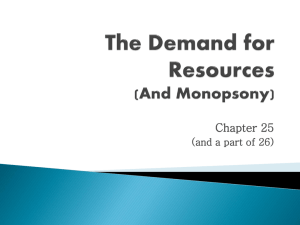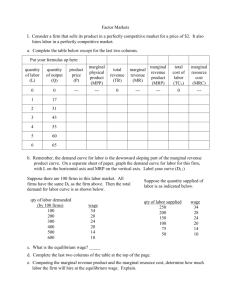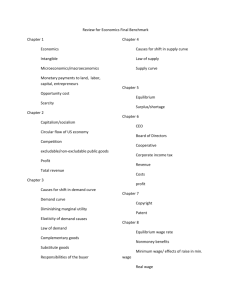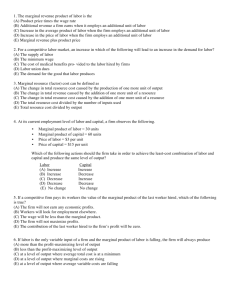The Market for Labor - Abernathy-ApEconomics-MPHS
advertisement
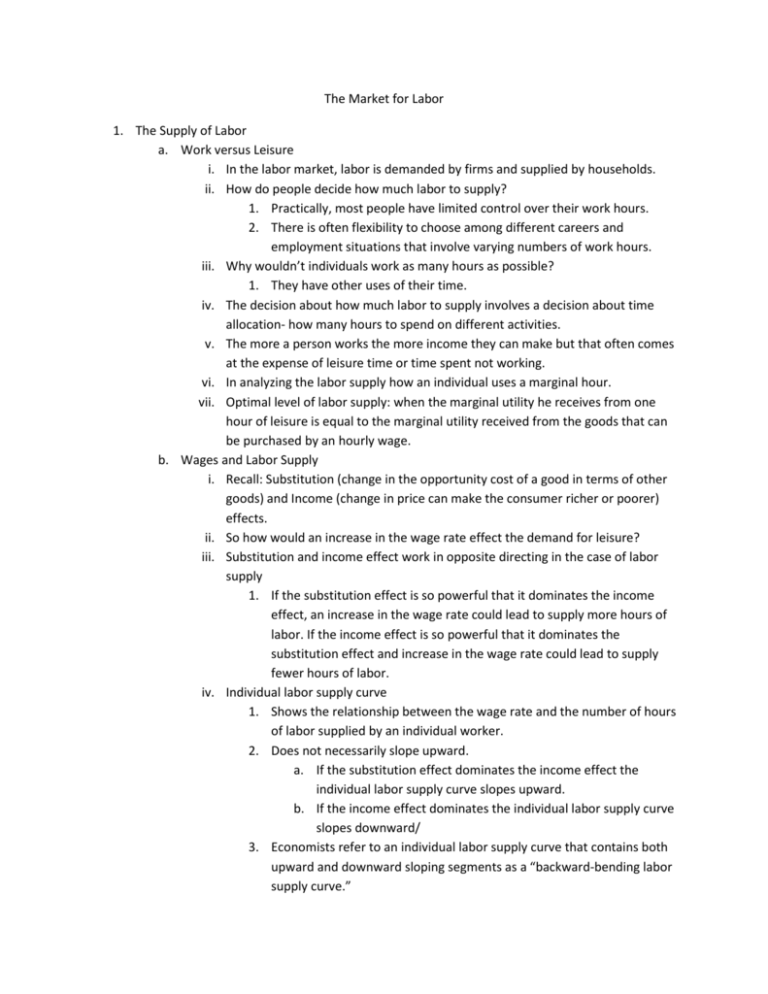
The Market for Labor 1. The Supply of Labor a. Work versus Leisure i. In the labor market, labor is demanded by firms and supplied by households. ii. How do people decide how much labor to supply? 1. Practically, most people have limited control over their work hours. 2. There is often flexibility to choose among different careers and employment situations that involve varying numbers of work hours. iii. Why wouldn’t individuals work as many hours as possible? 1. They have other uses of their time. iv. The decision about how much labor to supply involves a decision about time allocation- how many hours to spend on different activities. v. The more a person works the more income they can make but that often comes at the expense of leisure time or time spent not working. vi. In analyzing the labor supply how an individual uses a marginal hour. vii. Optimal level of labor supply: when the marginal utility he receives from one hour of leisure is equal to the marginal utility received from the goods that can be purchased by an hourly wage. b. Wages and Labor Supply i. Recall: Substitution (change in the opportunity cost of a good in terms of other goods) and Income (change in price can make the consumer richer or poorer) effects. ii. So how would an increase in the wage rate effect the demand for leisure? iii. Substitution and income effect work in opposite directing in the case of labor supply 1. If the substitution effect is so powerful that it dominates the income effect, an increase in the wage rate could lead to supply more hours of labor. If the income effect is so powerful that it dominates the substitution effect and increase in the wage rate could lead to supply fewer hours of labor. iv. Individual labor supply curve 1. Shows the relationship between the wage rate and the number of hours of labor supplied by an individual worker. 2. Does not necessarily slope upward. a. If the substitution effect dominates the income effect the individual labor supply curve slopes upward. b. If the income effect dominates the individual labor supply curve slopes downward/ 3. Economists refer to an individual labor supply curve that contains both upward and downward sloping segments as a “backward-bending labor supply curve.” a. At lower wage rates, the substitution effect dominates the income effect. b. At higher wage rates, the income effect eventually dominates the substitution effect. c. Shifts of the Labor Supply Curve i. Changes in Preferences and Social Norms 1. This can lead workers to increase or decrease their willingness to work at any given wage. a. Example: the large increase in the number of employed women, particularly married, employed woman that has occurred in the United States since the 1960s. ii. Changes in Population 1. A larger population tends to shift the labor supply curve to right as more workers are available at any given wage. 2. Smaller population tends to shift the labor curve leftward due to fewer available workers. iii. Changes in Opportunities 1. When superior alternatives arise for workers in another labor market, the supply curve in the original labor market shifts leftward as workers move to the new opportunities. 2. Similarly, when opportunities diminish in one labor market (layoffs) the supply in alternative labor markets increases as workers move to these other markets. iv. Changes in Wealth 1. When a class of workers experiences a general increase in wealth (i.e. a stock market boom) the income effect from the wealth increase will shift the labor supply curve associated with those workers leftward as workers consume more leisure and work less. a. Important distinction: the income effect caused by a change in wealth shifts the labor supply curve. The income effect from a wage rate increase is a movement along the labor supply curve. 2. Equilibrium in the Labor Market a. When the Product Market is not Perfectly Competitive i. When the product market is perfectly competitive, the wage rate is equal to the value of the marginal product of labor at equilibrium. ii. In other market structures this is not the case. 1. Example: monopoly a. The demand curve is downward sloping meaning that to sell an additional unit of output, the monopolist must lower the price. b. The additional revenue received from selling one more unit of output for a monopolists is not simply the price like it was for perfect competitor. c. It is less than the price by the amount of the price effect (the decreased revenue on units that could have been sold at a higher price if the price hadn’t been lowered to sell the another unit) 2. How does this affect hiring? a. To determine its demand for workers the monopolists must multiply the MPL by the marginal revenue received from selling the additional output. b. This is called the marginal revenue product of labor or MRPL. i. Formula: MRPL= MPL x MR c. For a perfectly competitive firm MR equals Price, so VMPL and MRPL is equivalent. i. The two concepts measure the same thing: the value to the firm of hiring an additional worker. d. MRPL can be applied in both perfect competition and imperfect competition. e. General rule: a profit maximizing firm in an imperfectly competitive product market employs each factor of production up to the point at which marginal revenue product of the last unit of the factor employed is equal to that factor’s cost. b. When the Labor Market is not Perfectly Competitive i. Important differences between an imperfectly competitive labor market and a perfectly competitive labor market. 1. Marginal Factor Cost a. It is the additional cost of hiring one more unit of a factor of production. b. Marginal factor cost of labor or MFCL i. Is the additional cost of hiring one more unit of labor ii. With perfect competition in the labor market, each firm is so small that it can hire as much labor as it wants at the market wage. 1. The firm’s hiring decision does not affect the market. 2. This means that additional cost of hiring another worker (MFCL) is always equal to the market wage. 3. The labor supply curve faced by an individual firm is horizontal. iii. With imperfect competition the labor supply curve faced by a firm is very different. 1. It is upward sloping and the marginal factor cost is above the market wage. 2. A firm in an imperfectly competitive market is large enough to affect the market wage. a. Example: a labor market in which there is only one firm hiring labor is called a monopsony. b. A monopsonist is a single buyer of a factor. 3. The additional cost of hiring an additional worker is higher than the wage: it is the wage plus the raises paid to all workers a. This means that the MFCL is above the labor supply curve. 4. The marginal factor cost is the wage plus the wage increase for those workers who could otherwise be hired at the lower wage. c. Equilibrium in the Imperfectly Competitive Labor Market i. In a perfectly competitive market firms hire labor until the value of the marginal product of labor equals market wage. ii. With imperfect competition in a factor market, a firm will hire additional workers until the marginal revenue product of labor equals the marginal factor cost of labor. Or MRPL = MFCL iii. Equilibrium 1. Is found where the marginal revenue product equals the marginal factor cost.


